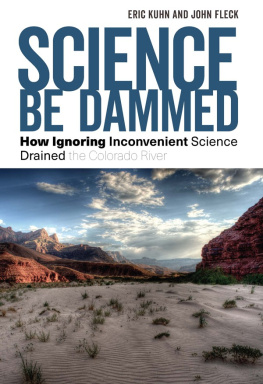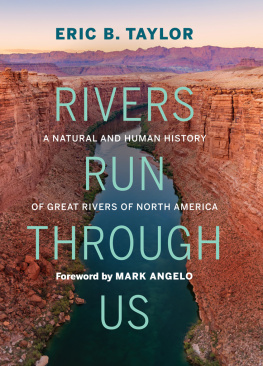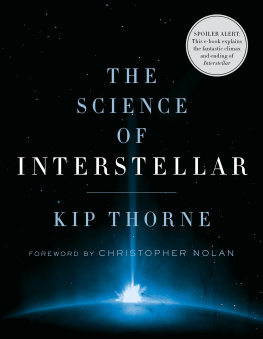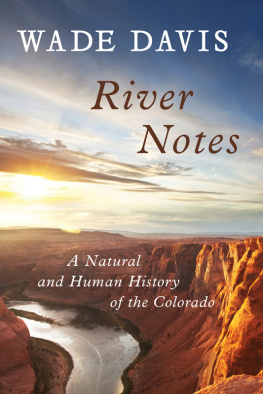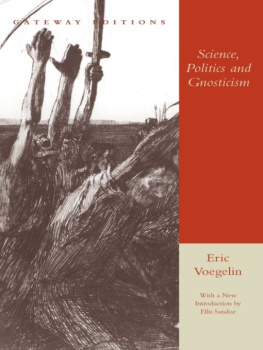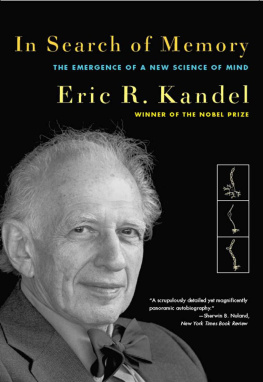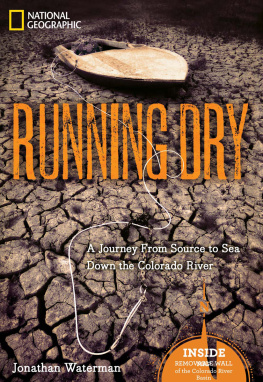Eric Kuhn - Science Be Dammed : How Ignoring Inconvenient Science Drained the Colorado River
Here you can read online Eric Kuhn - Science Be Dammed : How Ignoring Inconvenient Science Drained the Colorado River full text of the book (entire story) in english for free. Download pdf and epub, get meaning, cover and reviews about this ebook. year: 2019, genre: Politics. Description of the work, (preface) as well as reviews are available. Best literature library LitArk.com created for fans of good reading and offers a wide selection of genres:
Romance novel
Science fiction
Adventure
Detective
Science
History
Home and family
Prose
Art
Politics
Computer
Non-fiction
Religion
Business
Children
Humor
Choose a favorite category and find really read worthwhile books. Enjoy immersion in the world of imagination, feel the emotions of the characters or learn something new for yourself, make an fascinating discovery.
- Book:Science Be Dammed : How Ignoring Inconvenient Science Drained the Colorado River
- Author:
- Genre:
- Year:2019
- Rating:4 / 5
- Favourites:Add to favourites
- Your mark:
- 80
- 1
- 2
- 3
- 4
- 5
Science Be Dammed : How Ignoring Inconvenient Science Drained the Colorado River: summary, description and annotation
We offer to read an annotation, description, summary or preface (depends on what the author of the book "Science Be Dammed : How Ignoring Inconvenient Science Drained the Colorado River" wrote himself). If you haven't found the necessary information about the book — write in the comments, we will try to find it.
Eric Kuhn: author's other books
Who wrote Science Be Dammed : How Ignoring Inconvenient Science Drained the Colorado River? Find out the surname, the name of the author of the book and a list of all author's works by series.
Science Be Dammed : How Ignoring Inconvenient Science Drained the Colorado River — read online for free the complete book (whole text) full work
Below is the text of the book, divided by pages. System saving the place of the last page read, allows you to conveniently read the book "Science Be Dammed : How Ignoring Inconvenient Science Drained the Colorado River" online for free, without having to search again every time where you left off. Put a bookmark, and you can go to the page where you finished reading at any time.
Font size:
Interval:
Bookmark:

The University of Arizona Press
www.uapress.arizona.edu
2019 by The Arizona Board of Regents
All rights reserved. Published 2019
ISBN-13: 978-0-8165-4005-1 (cloth)
Cover design by Carrie House, HOUSEdesign llc
Cover photo: Delta of the Colorado River in the Grand Canyon by mundoview/Shutterstock
The publisher and authors gratefully acknowledge the generous support for this book provided by the board of directors and staff of the Colorado River Water Conservation District.
The views and opinions expressed in the book are those of the authors alone and do not represent the views and policies of the District.
Library of Congress Cataloging-in-Publication Data are available at the Library of Congress.
Printed in the United States of America This paper meets the requirements of ANSI/NISO Z39.481992 (Permanence of Paper).
This paper meets the requirements of ANSI/NISO Z39.481992 (Permanence of Paper).
ISBN-13: 978-0-8165-4043-3 (electronic)
In the epilogue to his classic Water and the West, historian Norris Hundley captured the problem at the heart of sustainably managing the waters of the Colorado River Basin in the twenty-first century:
Basin of Contention would be an apt name for what generations have called the Colorado River Basin. A limited supply of water in a vast and semi-arid region is hardly a recipe for tranquility among those who covet the water. The drafters of the compact were clearly aware of that truism, but they nonetheless failed to determine with reasonable accuracy the long-term annual flow of the Colorado River.
The implications of that failure are profound. There is less water in the Colorado River, over the long run, than the farms and cities across and adjacent to the Colorado River Basin have come to expect and depend on. One of us, Eric Kuhn, now the retired general manager of the Colorado River Water Conservation District, spent a career wrestling with the implications of that failure. The River District spans the Colorado River headwaters of western Colorado. The struggle for sustainability starts there, because about two-thirds of the rivers waters start there. During the many plane flights andhotel evenings spent traveling the basin for gatherings of water managers wrestling with the problem, Hundleys book was often in Erics backpack as he thought about the question of how we got to this point.
Two things came to mind. The first was an observation by his predecessor and mentor at the River District, Rolly Fischer (19282016). One of Fischers favorite sayings about the river was that the tried-and-true method to solve disputes in the Colorado River Basin was to promise the combatants more water than was available in the river, then hope a future generation would fix the mess. The second was the words of Hundley. His book, first published in 1975, is the go-to resource on the negotiations and ratification of the Colorado River Compact. By the time the books second edition was published in 2009, the problem of scarcity, of the overallocation of the Colorado River, had become acute, and Hundley reflected on the reasons. When the framers of the 1922 Colorado River initially parceled out the water, he wrote,
they had a glaring need for sound information, but no concerted attempt was made to call on the scientific community for help. The drafters were mesmerized by their desire for haste and their political and personal goals. Without authoritative data, they had an opportunity to pick and choose information that best suited their interests and uncertainties. And that is what they did. The situation would not significantly change until others recognized and studied the importance of tree-ring datadata that revealed a distinct pattern, going back centuries, of severe and lengthy droughts, and the probability this pattern will continue in the future. The consequences of the compact remain with us.
While Kuhn was toting Hundley to Colorado River Basin management meetings, the other of us, John Fleck, was trying to make sense of the implications of another classic in the Colorado River literature. Purchased from a rare book dealer in the winter of 2012, Flecks copy of hydrologist E. C. LaRues 1916 U.S. Geological Survey report entitled Colorado River and Its Utilization bears the yellowing of a century. A New Mexicobased journalist drifting away from newspaper work toward an academic career, Fleck was puzzling over the same questions as Kuhn. As Albuquerque, his hometown, increasingly came to depend on Colorado River water, overallocation and scarcity made the problems of the basin personal. LaRues work seemed tohold the key to understanding how science had informed the decisions that brought us to this point.
The conventional story of how this happened, enshrined in Marc Reisners seminal 1986 book Cadillac Desert, is that in overestimating the available supply of water, the authors of the 1922 Colorado River Compact did the best with what they hadabout eighteen years of streamflow measurement.... During all of that period, the river had gone on a binge. Our great misfortune, that conventional story would have us believe, was that the compacts framers could not have known that they were allocating the water during unusually wet times.
Hundleys criticism brings us part way to correcting the mistake in that conventional story. Yes, as Reisner argues, the 1922 Colorado River Compact negotiators proceeded without a good working knowledge of the rivers hydrology. Yes, as Hundley argues, the commissioners were profoundly incurious about the question. But the history is more complicated.
The decision-makers actually had available, had they chosen to use it, a relatively thorough, complete, and almost modern picture of the rivers hydrology. Had they chosen to use the information, they had at hand more than Reisners eighteen years of streamflow measurement. They had available, but chose not to use, data suggesting a much smaller river in the years prior to the eighteen years on which they were relying. Had they taken the science seriously, they almost certainly would have concluded that the Colorado River had less water than the common assumptions underpinning their race to develop the river.
We cannot know what they might have done had they used this information. Accepting this science might have left them with a flow too low, and projected drought periods too severe to reach the compromises necessary to carve up the river among the states and develop its waters. The basic problem was neither the lack of good science nor the ability of the decision-makers to understand the basins hydrology. The decision-makers were in fact intelligent, accomplished, and skilled professionals. The problem was that in an era driven by politics of competition for a limited supply of river water and federal dollars, the decision-makers had the opportunity to selectively use the available science as a tool to sell their projects and vision for the rivers future to Congress and the general public. This approach used bythe compact commissioners set a precedent that would continue for decades and color most of the major policy decisions on the river in a way that still wields undue influence today.
Today, the Colorado River is fully used, most would say overused. Unless it is by careful design, as happened in the spring of 2014 with an experimental environmental pulse flow, not a drop of Colorado River water makes it to the Sea of Cortez. Demands for the rivers waters already exceed the available supply, a situation that will only grow more difficult with continued growth and the impacts of climate change.
Font size:
Interval:
Bookmark:
Similar books «Science Be Dammed : How Ignoring Inconvenient Science Drained the Colorado River»
Look at similar books to Science Be Dammed : How Ignoring Inconvenient Science Drained the Colorado River. We have selected literature similar in name and meaning in the hope of providing readers with more options to find new, interesting, not yet read works.
Discussion, reviews of the book Science Be Dammed : How Ignoring Inconvenient Science Drained the Colorado River and just readers' own opinions. Leave your comments, write what you think about the work, its meaning or the main characters. Specify what exactly you liked and what you didn't like, and why you think so.

